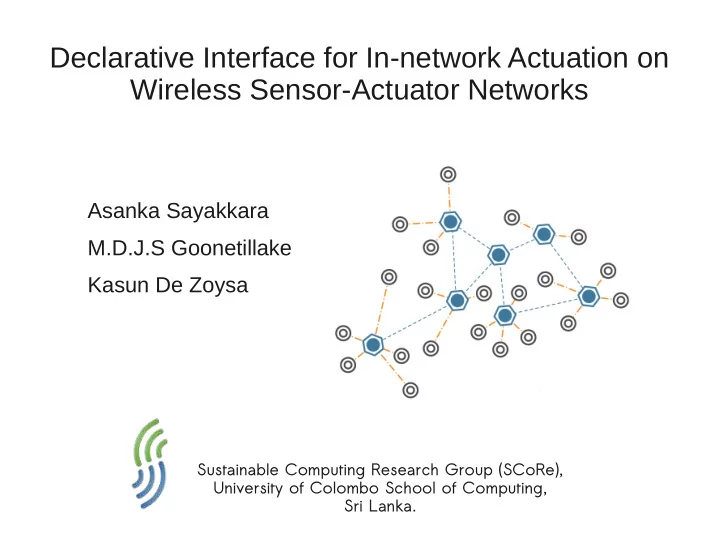

Declarative Interface for In-network Actuation on Wireless Sensor-Actuator Networks Asanka Sayakkara M.D.J.S Goonetillake Kasun De Zoysa Sustainable Computing Research Group (SCoRe), University of Colombo School of Computing, Sri Lanka.
Outline ● Wireless sensor networks (WSN) ● Database abstraction for WSN ● Cougar and TinyDB ● Wireless sensor actuator networks (WSAN) ● TinyDB for WSAN ● Greenhouse scenario ● Issues in declarative interface for WSAN ● Solution approach ● Evaluation ● Discussion ● Conclusion
Wireless Sensor Networks (WSN) ● Low powered devices. ● Wireless communication. ● Limited computing resources. ● Built-in sensors.
Database Abstraction for WSN ● Hides the complex network details and provide a familiar interface.
Cougar and TinyDB ● Cougar from Cornell University ➔ The pioneering work in the domain. ➔ In network query processing ● TinyDB as a joint work from MIT, UCB and Intel Research ➔ First successful implementation. ➔ Widely used in real world applications SELECT nodeid, light FROM sensors SAMPLE PERIOD 1 FOR 10; Specify Data Sampling Rate
Wireless Sensor Actuator Networks (WSAN) ● Having just sensors in the network is not enough. ● New requirements for controlling the deployed environment in addition to monitoring. ● Actuators are attached to the nodes in a network. ● Some nodes may have just sensors, some may have just actuators and some may carry both sensors and actuators.
TinyDB for WSAN ● Special keywords to specify which action should be performed. ● Calls to low level system functions. SELECT nodeid,temperature The function FROM sensors to be Called WHERE temperature > 25 OUTPUT ACTION sprinkler-on() SAMPLE PERIOD 10s Specify Data Sampling Rate
The Greenhouse Scenario ● A greenhouse with wireless sensors and actuators. (Only the components Of our concern are shown)
The Greenhouse Scenario (continued) SELECT nodeid FROM sensors WHERE (nodeid=5 OR nodeid=7) AND temperature>35 AND humidity>45 ONCE ; SELECT nodeid FROM sensors WHERE nodeid=9 OUTPUT ACTION air-cooler-on() ONCE ; SELECT nodeid FROM sensors WHERE nodeid=15 OUTPUT ACTION screen-ctrl-on() ONCE ; SELECT nodeid FROM sensors WHERE nodeid=23 OUTPUT ACTION sprinkler-on() ONCE ;
Issues In Declarative Interface For WSAN 1. Violation of declarative nature. 2. Inefficiency in complex actuation tasks.
Solution Approach ● Actuators were not the concern of TinyDB developers. ● Data acquisition query syntax has been extended to support actuators using a new keyword. ● To solve declarative nature violations we need better query syntax for actuation tasks.
Virtual Data Table nodeid temperature humidity 1 25 40 Traditional 2 28 39 Sensors table 3 27 NULL 4 NULL 41 Enhanced table With sensors And actuators nodeid temperature humidity air-cooler sprinker 1 25 40 NULL NULL 2 28 39 off off 3 27 NULL on NULL 4 NULL 41 off on
Actuation By Updates ● Actuator attributes in the table are alterable. ● We can update actuator attributes by using traditional update queries. UPDATE sensors SET air_cooler=’on’ WHERE nodeid=2 AND temperature>20 ONCE ; Still we need to specify sampling rate
Actuation By Updates (continued) ● Multiple nodes can involve for a single actuation task. ● Alias can be used to perform such tasks. Such as Greenhouse scenario UPDATE sensors AS sen, sensors AS act SET act.air_cooler=’on’ WHERE (act.nodeid=4 OR act.nodeid=2) AND (sen.nodeid=1 AND sen.temperature>20) ONCE ;
Query Execution
Evaluating Declarative Nature ● Randomly selected a group of 10 students who have an average knowledge on acquisitional queries. ● Provided them with different actuation scenarios and asked them to write SQL queries to perform those actuation tasks in both existing and the suggested approaches. ● Collected feedback from them regarding how they found writing queries for actuation tasks in both approaches.
Evaluating Declarative Nature (continued) ● Each person participated in the survey considers the existing approach of performing actuation tasks has unnecessary syntax restrictions. ● All the participants consider the modified virtual table with actuators as attributes is more convenient to handle than the old table. ● Most of them have struggled to write queries using the existing syntax for the greenhouse scenario.
Actuation Time ● Actuation time Vs Number of fields in a query.
Discussion ● Having NULL values in the virtual table doesn't add any overhead to the query execution cost. ● Adding a list of functions to TinyDB query syntax can reduce the multiple query usage to some extent. But still declarative nature violation remains. ● Node mobility should be seriously considered in the future. ● Require efficient ways to execute UPDATE queries in the network.
Conclusion ● Considering actuators as a part of the data model in the database abstraction is more convenient. ● UPDATE queries can be used to perform actuation tasks in the network. ● Executing actuation queries in the network needs more research to handle node movements, node failures, etc.
Recommend
More recommend